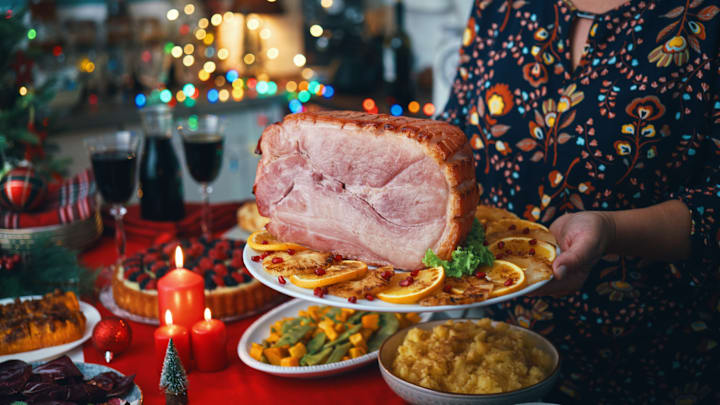Many Christmas traditions have roots predating the holiday itself. The Gaels and Celts burned “Yule logs” during their winter solstice celebrations, and people have been using evergreens to decorate their homes for winter since before the dawn of Christianity. You may not question the prevalence of ham around the holiday, but even this tradition has pagan origins.
Though not as closely tied to Christmas as turkey is to Thanksgiving, ham is still considered the classic protein to serve on December 25 (at least since Christmas peacock and goose fell out of fashion). The spiral-sliced and honey-baked version is a relatively new addition to the holiday table, but pork has been part of winter feasts for centuries.
According to Wane.com, the precursor to Christmas ham may have been wild boar. The Norse people associated boar with Freyr—the god of fertility and good weather—and they sacrificed the animal to appease him. Germanic pagans folded the hunt for wild game and the subsequent feast into their annual Yuletide festivities marking the return of the sun.
When early Christians were looking for an opportunity to celebrate Christ’s birth in the 4th century CE, winter solstice made perfect sense. It was already a time of feasting throughout much of Europe. Rather than stamping Germanic Yuletide out of Roman Saturnalia completely, Christians repurposed these celebrations to fit their new religion.
Boar survived the transition to Christmas, but instead of a sacrifice to Freyr it became associated with St. Stephen, whose feast day falls on December 26. Boar head was a staple of Christmas feasts during the Middle Ages. Some old recipes instructed cooks to rub the pig with lard and ash to recreate the creature’s black fur.
Around the mid-20th century, cured pork thigh—a.k.a. ham—became Americans’ preferred way to eat pig on Christmas (and other Christian celebrations). Cost was a driving factor behind the dish’s popularity. According to the U.S. Bureau of Labor Statistics, ham cost 62 cents per pound on average in 1950. For comparison, it cost 74 cents for a pound of lamb, 74 cents for beef rib roast, and 94 cents for steak that same year. Advertisements encouraging cooks to dress up ham for the holidays with cloves, pineapple slices, and maraschino cherries helped boost the meat’s festive reputation.
Don’t let the addition of canned fruit fool you: Ham is as classic as any dish served around the winter holidays. When you sit down to dinner this Christmas, be thankful you didn’t have to sacrifice the pig yourself (and that you’re eating its leg instead of its head).
Discover More Stories About Christmas:
A version of this story originally ran in 2022; it has been updated for 2024.
